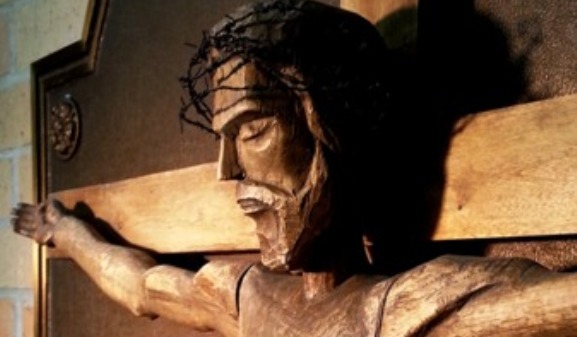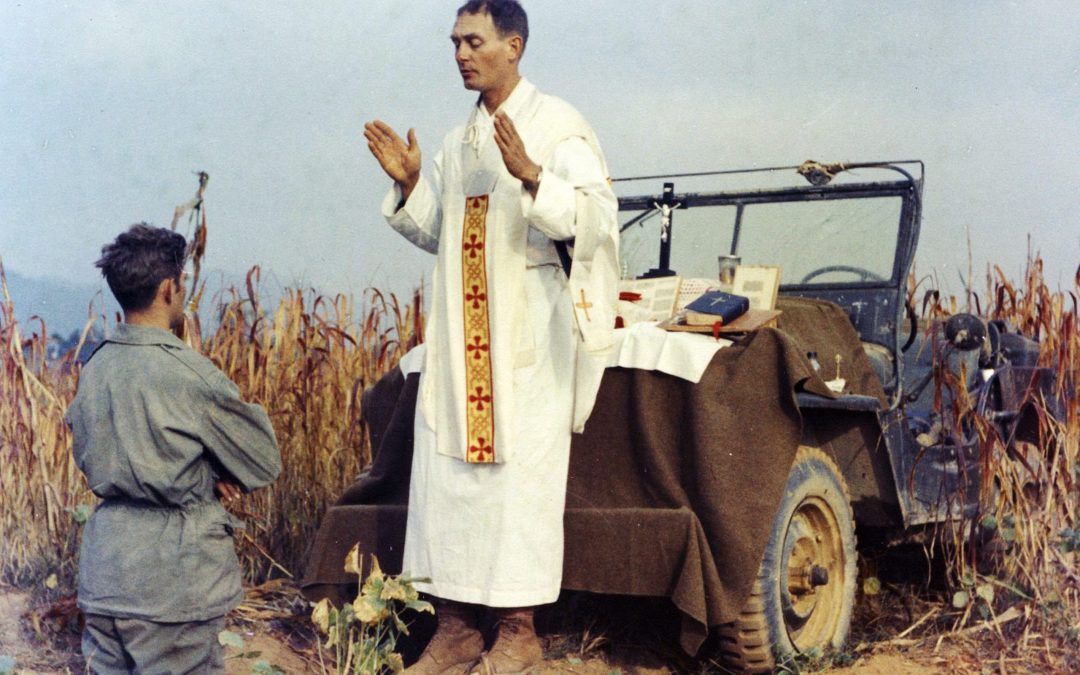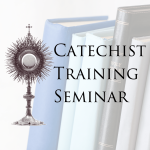And the king will say to them in reply, ‘Amen, I say to you, whatever you did for one of these least brothers of mine, you did for me.’ – Matthew 25:40
Servant of God CH (CAPT) Fr. Emil Joseph Kapaun was laid to rest at the Cathedral of the Immaculate Conception in Wichita, Kansas on Wednesday, September 29th of this year. He was brought to his final resting place after 70 years of being among thousands of unidentified soldiers interred at the National Cemetery of the Pacific in Hawaii. His story is one of inspiration to so many people. I’ve especially been inspired by his story for a number of reasons, primarily because of his selfless service to fellow prisoners of war in a filthy death camp in North Korea in 1951.
Emil Joseph Kapaun was born in the warm kitchen of the farmhouse on the family farm in rural Pilsen, Kansas on April 20, 1916, Holy Thursday. He was destined for a life of service, first on the family farm, and later as a priest. His parents had come to America from Czechoslovakia and settled in the fertile plains of central Kansas.
Young Emil was a hard worker who took to his farming tasks with zeal and enthusiasm. His skills working with farm tools would assist him in the hellhole of a Korean prisoner of war camp from 1950-1951.
His first Mass was in his home parish of St. John Nepomucene Church in Pilsen. Having been ordained a priest in 1940, he joined the U.S. Army Chaplain Corps in 1944. Fr. Kapaun was assigned to Burma and India at the end of WWII. He was promoted to Captain in January 1946, and finished his military service shortly thereafter. He then attended Catholic University of America for a Master’s Degree in Education and, having a deep desire to serve in the military, he returned to active military service in 1948.
CH (CAPT) Kapaun was assigned to Japan in 1950 with the 1st Cavalry Division peace-keeping forces. This peaceful prelude was interrupted abruptly on June 25, 1950. Communist North Korea invaded South Korea, beginning a bloody war that is today regarded as one of the most brutal experiences America’s military has ever engaged. The Korean War was among the most destructive conflicts of the modern era, with approximately 3 million war fatalities and a larger proportional civilian death toll than World War II or the Vietnam War.
It incurred the destruction of virtually all of Korea’s major cities, thousands of massacres by both sides, including the mass killing of tens of thousands of suspected communists by the South Korean government, and the torture and starvation of prisoners of war by the North Koreans. North Korea became among the most heavily bombed countries in history. Additionally, several million North Koreans are estimated to have fled North Korea over the course of the war.
Against this background of history, the 8th Cavalry Regiment, 1st Cavalry Division deployed to Korea with Fr. Kapaun along the way.
In hellish battle after battle, Fr. Kapaun risked his life again and again to assist his soldiers, offering the sacraments to troops in foxholes, carrying wounded and burying the dead – even enemy soldiers – and giving aid and comfort wherever he could. He constantly brushed up against death himself.
On November 1, 1950, All Saints Day, Fr. Kapaun celebrated Mass for the troops and it appeared the war was about to be over as they had stopped North Korea’s advancement. On November 2, All Souls Day, 20,000 Chinese soldiers swarmed their camp in a surprise attack, capturing the American soldiers.
Forced to walk 87 miles to a prisoner of war camp, soldiers who could not walk were shot on sight. Fr. Kapaun took to carrying anyone who could on his back and recruited others able to do so to carry others as well.
Now in Prison Camp 5, Fr. Kapaun served the prisoners selflessly, cleaning and tending to wounds, melting snow for clean water, scavenging for morsels of food (calling on St. Dismas, the good thief, for intercession). He served men of all faiths, adapting prayers to their faith practices, and to those with no faith at all.
Fr. Kapaun fell ill after Easter 1951. Pneumonia and blood clots had finally taken their toll on his body. The Chinese captors decided to take him to the camp “hospital”, which was actually a death chamber, to be left to die.
His fellow prisoners were equally determined that he would not be taken to the death house, and resisted the captors taking him away from them. Fr. Kapaun stopped them, saying “it is time. I am going where I have wanted to go. I will be praying for all of you.” As his fellow prisoners carried him to the death house, he stopped numerous times and offered blessings, even to his captors.
In that death house, Fr. Kapaun died alone on May 23, 1951 – 35 years young.
But the story doesn’t end there. Surviving prisoners carried on his legacy and work for another two years, until the end of hostilities in mid-1953, when they were liberated by American troops.
During the remaining two years of captivity, Maj. Gerald Fink was transferred to Prison Camp 5. He found the men there unlike any other prison camp where he had been held. With the memory of Fr. Kapaun on their minds and his life of service etched upon their hearts, the men here looked after one another, encouraging one another, keeping each other’s spirits up, knowing one day they would be going home.
Maj. Fink was of the Jewish faith, but no matter. Taken by the stories of Fr. Kapaun – having never met him – he carved a crucifix out of Cherrywood, with metal for the corpus that had been scavenged from around the camp. Upon liberation in 1953, the men would not leave the camp without the crucifix. It was a sticky issue with the Chinese for a couple of hours before they acquiesced and allowed the men to march out of the camp with the crucifix. That crucifix is now permanently on display in Kapaun Mt. Carmel High School in Wichita.

Fr. Kapaun’s earthly remains were unidentified for 70 years until March 2021. His remains, along with thousands of other soldiers, had been delivered to the American authorities shortly after the war and were buried in Honolulu with hundreds of other unidentified soldiers.
Finally identified in March of this year, his remains were returned to his family in Kansas in September amid a great outpouring of respect and ceremony benefiting someone many are calling a saint. A series of services commemorating his life and service were held, beginning with a homecoming Mass at his home parish of St. John Nepomucene in Pilsen, where he celebrated his first Mass as a priest. Following that, a Mass of Christian Burial was held in Hartman Arena in Wichita, followed by entombment at the Cathedral of the Immaculate Conception. At this final resting place, his memory will be honored, never forgotten, and many people will come to know of his saintly life.
Seventy years after dying a horrible death in a filthy Korean prisoner of war camp, Fr. Kapaun is “Home at Last”.
Five of the men who were in the prisoner of war camp with Fr. Kapaun are still alive and attended the funeral Mass. One of the men, Herbert Miller, was a person Fr. Kapaun carried on that first march to the death camp. Herbert Miller lives because Fr. Kapaun put his life ahead of his own.
Fr. Kapaun’s story has been told ever since the Korean Conflict ended by the men who were there in the camp with him. Efforts to recognize his heroic sacrifices resulted in his being declared a Servant of God by Pope John Paul II in 1993. There are at least two miracles now under investigation and his canonization process continues. For many people, especially the men with whom he served, his sainthood is already affirmed.
Fr. Kapaun has been awarded many accolades. The Congressional Medal of Honor, the Bronze Star, the Distinguished Service Cross, the Legion of Merit, among others. To have him elevated to the altars would be a fitting tribute to his life of humble service.
Why does this man’s story strike so deep in my heart? Would I have the love, faith and courage to do what Fr. Kapaun did? Would I break and run at the first sign of trouble? Would I be able to withstand the terrible conditions of a prisoner of war camp for any amount of time?
Fr. Kapaun’s story has resonated with me to know of the heroism, bravery, steadfast spirit and fortitude of many of our military chaplains in all of the wars in which our country has been engaged.
I’m especially touched because my uncle, Charlie Weisenberger, died on the battlefield in Luxembourg in World War II. He was in the 80th Infantry Division with the ground troops as they fought to push the German Army back into Germany in the infamous Battle of the Bulge.
I often wonder if he had a chaplain close by as the battle raged. As he lay wounded on the battlefield, was he able to receive some consolation and absolution before succumbing to his wounds? Was another Fr. Kapaun close by to render aid, risking his own life so that Uncle Charlie would have the sacraments with which to enter eternal life in a state of grace?
To learn more about Fr. Kapaun, visit frkapaun.org.



